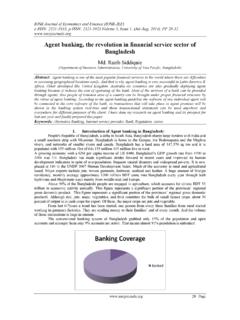Transcription of ARTICLE IN PRESS - Nanomedicine
1 EDITORIALN anotechnology, Nanomedicine and nanosurgeryAn exciting revolution in health care and med-ical technology looms large on the horizon. Yet theagents of change will be microscopically small,future products of a new discipline known asnanotechnology. Nanotechnology is the engineer-ing of molecularly precise or smallereand, ultimately, the application of nano-technology to medicine. It is the preservationand improvement of human health, using molecu-lar tools and molecular knowledge of the humanbody. Present-day Nanomedicine exploits carefullystructured nanoparticles such as dendrimers,5car-bon fullerenes (buckyballs)6and nanoshells7totarget specific tissues and organs. These nanopar-ticles may serve as diagnostic and therapeutic an-tiviral, antitumor or anticancer agents.
2 But as thistechnology matures in the years ahead, complexnanodevices and even nanorobots will be fabri-cated, first of biological materials but later usingmore durable materials such as diamond toachieve the most powerful visionCan it be that someday nanorobots will be able totravel through the body searching out and clearingup diseases, such as an arterial atheromatousplaque?8 The first and most famous scientist tovoice this possibility was the late Nobel physicistRichard P. Feynman. In his remarkably prescient1959 talk There s Plenty of Room at the Bottom, Feynman proposed employing machine tools tomake smaller machine tools, these are to beused in turn to make still smaller machine tools,and so on all the way down to the atomic level,noting that this is a development which I thinkcannot be avoided.
3 9 Feynman was clearly aware of the potentialmedical applications of this new technology. Heoffered the first known proposal for a nanoroboticsurgical procedure to cure heart disease: A friendof mine (Albert R. Hibbs) suggests a very interest-ing possibility for relatively small machines. Hesays that, although it is a very wild idea, it wouldbe interesting in surgery if you could swallow thesurgeon. You put the mechanical surgeon insidethe blood vessel and it goes into the heart andlooks around. (Of course the information has to befed out.) It finds out which valve is the faulty oneand takes a little knife and slices it [Imag-ine] that we can manufacture an object thatmaneuvers at that level!.Other small machinesmight be permanently incorporated in the body toassist some inadequately functioning organ.
4 9 Medical microroboticsThere are ongoing attempts to build microrobotsfor in vivo medical use. In 2002, Ishiyama et al. atTohoku University developed tiny magneticallydriven spinning screws intended to swim alongveins and carry drugs to infected tissues or even toburrow into tumors and kill them with , the MR-Sub project of Martel s group atthe NanoRobotics Laboratory of Ecole Polytechni-que in Montreal tested using variable MRI magneticfields to generate forces on an untethered micro-robot containing ferromagnetic particles, develop-ing sufficient propulsive power to direct the smalldevice through the human Nelson steam at the Swiss Federal Institute of Technologyin Zurich continued this approach. In 2005, theyreported the fabrication of a microscopic robotsmall enough (w200mm) to be injected into thebody through a syringe.
5 They hope that this deviceor its descendants might someday be used to de-liver drugs or perform minimally invasive eyeARTICLE IN PRESS1743-9191/$ - see front matter 2005 Surgical Associates Ltd. Published by Elsevier Ltd. All rights Journal of Surgery (2005)-, s simple microrobot has success-fully maneuvered through a watery maze using ex-ternal energy from magnetic fields, with differentfrequencies that are able to vibrate different me-chanical parts on the device to maintain selectivecontrol of different functions. Gordon s group atthe University of Manitoba has also proposed mag-netically controlled cytobots and karyobots for performing wireless intracellular and intranu-clear medical nanorobotsThe greatest power of Nanomedicine will emerge,perhaps in the 2020s, when we can design andconstruct complete artificial nanorobots using rigiddiamondoid nanometer-scale parts like moleculargears (Fig.)
6 1) and nanorobotswill possess a full panoply of autonomous subsys-tems including onboard sensors, motors, manipula-tors, power supplies, and molecular getting all these nanoscale components tospontaneously self-assemble in the right sequencewill prove increasingly difficult as machine struc-tures become more complex. Making complexnanorobotic systems requires manufacturingtechniques that can build a molecular structureby what is called positional assembly. This will in-volve picking and placing molecular parts one byone, moving them along controlled trajectoriesmuch like the robot arms that manufacture carson automobile assembly lines. The procedure isthen repeated over and over with all the differentparts until the final product, such as a medicalnanorobot, is fully positional assembly of diamondoid struc-tures, some almost atom by atom, using molecularfeedstock has been examined theoretically14,15viacomputational models of diamond mechanosyn-thesis (DMS).
7 DMS is the controlled addition of car-bon atoms to the growth surface of a diamondcrystal lattice in a vacuum-manufacturing environ-ment. Covalent chemical bonds are formed one byone as the result of positionally constrained me-chanical forces applied at the tip of a scanningprobe microscope apparatus, following a pro-grammed sequence. Mechanosynthesis using sili-con atoms was first achieved experimentally atoms should not be far be practical, molecular manufacturing mustalso be able to assemble very large numbers ofmedical nanorobots very quickly. Approaches un-der consideration include using replicativemanufacturing systems or massively parallel fabri-cation, employing large arrays of scanning probetips all building similar diamondoid product struc-tures in example, simple mechanical ciliary arraysconsisting of 10,000 independent microactuators ona 1-cm2chip have been made at the Cornell Nation-al Nanofabrication Laboratory for microscale partstransport applications, and similarly at IBM for me-chanical data storage probearrays of 10,000 independently actuated micro-scope tips have been developed by Mirkin s groupat Northwestern University for dip-pen nanolithog-raphy20using DNA-based ink.
8 Almost any desired2D shape can be drawn using 10 tips in concert. An-other microcantilever array manufactured by Proti-veris Corp. has millions of interdigitated cantileverson a single chip. Martel s group has investigatedusing fleets of independently mobile wireless in-strumented microrobot manipulators called Nano-Walkers to collectively form a nanofactory systemthat might be used for positional Corp. ( )ofRichardson, TX has a $25 million, five-year, NationalInstitute of Standards and Technology (NIST) con-tract to develop prototype microscale assemblersusing microelectromechanical systems. This re-search may eventually lead to prototype nanoscaleassemblers using nanoelectromechanical 1A molecular planetary gear is a mechanicalcomponent that might be found inside a medical nanoro-bot.
9 The gear converts shaft power from one angular fre-quency to another. The casing is a strained silicon shellwith predominantly sulfur termination, with each ofthe nine planet gears attached to the planet carrier bya carbonecarbon single bond. The planetary gear shownhere has not been built experimentally but has beenmodeled computationally. Copyright 1995 Institute forMolecular Manufacturing (IMM). ARTICLE IN PRESS2 EditorialRespirocytes and microbivoresThe abil ity to build compl ex diamondo id medi calnanoro bots to mole cular pre cision, and the n tobuild the m cheaply enough in sufficient ly largenumbers to be useful thera peuticall y, will revo lu-tioniz e the pra ctice of medi cine and surger y. 1 Thefirst theoreti cal de sign study of a compl ete medi-cal nanorobo t ever publish ed in a peer-rev iewedjournal (in 1998) described a hy pothetica l artifici almecha nical re d blood cell or re spirocyt e madeof 18 b illion preci sely arr anged structur al atom resp irocyte is a bloodborne spheri cal 1- m m di-amo ndoid 1000-atm osphere pressure vess el withrevers ible molec ule-selec tive surface pumps pow-ered by end ogenous serum glucos e.
10 This nanoro botwould deliver 236 times more oxygen to bod y tis-sues per unit volume tha n nat ural red cells andwould ma nage carbo nic acidity, cont rolled by gasconc entratio n sensors and an onboard nanoco m-puter. A 5-cc thera peutic dose of 50% resp irocytesaline suspen sion conta ining 5 trillio n nano robotscould exactly repl ace the gas car rying capaci ty ofthe patient s entir e l of obotic artifi cial phagocyt es called micro-bivores (Fig. 2) could patro l the bloodstrea m,seekin g out and diges ting unwant ed pat hogens in-clud ing bacte ria, virus es, or fungi. 23 Micro bivoreswould achie ve compl ete clearan ce of even themost severe septicem ic infections in hours orless.






